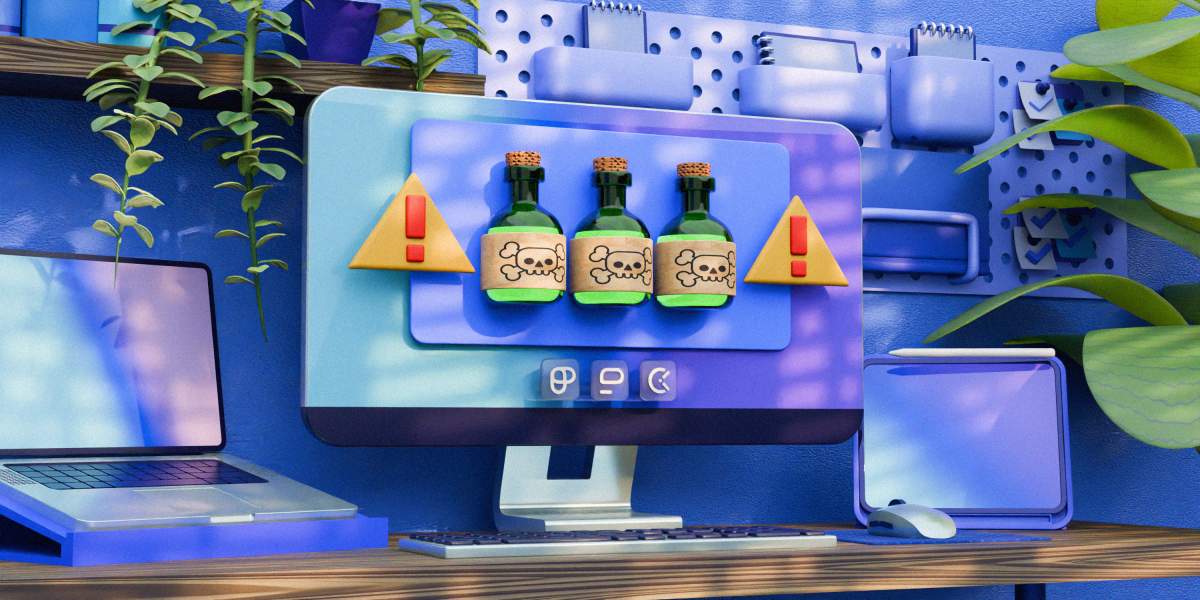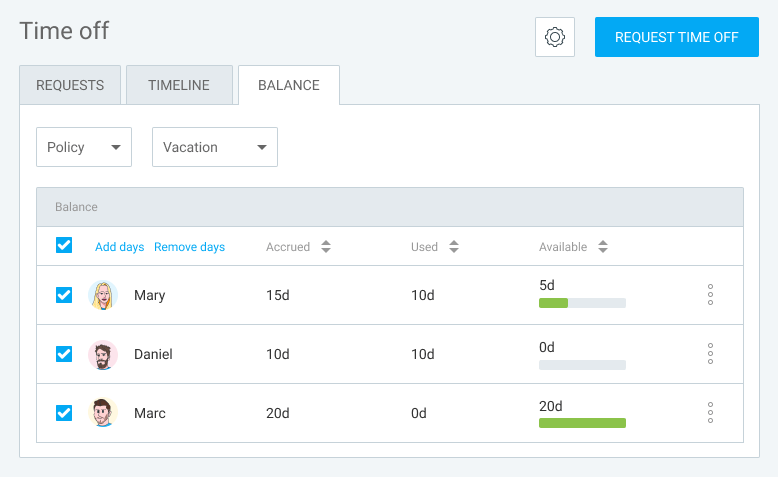A toxic workplace can be a breeding ground for negativity, stress, and conflict. It could lead to decreased productivity and morale and even have serious consequences on an employee’s physical and mental health.
But how can you tell if your workplace is toxic? Is there a way to deal with toxic work dynamics?
That’s what we’re trying to explore in this article, by shedding light on:
- What a toxic work environment is,
- What the common toxic workplace signs are, and
- How to deal with an unhealthy work environment.

Table of Contents
What is a toxic work environment?
A toxic work environment is one where employees find it difficult to work or progress due to the negative atmosphere created by coworkers, supervisors, or the company culture itself.
Editor-in-chief at Made in CA, Annie Morris, explains that toxic jobs come with constant pressure and fear:

“An unhealthy workplace is one where people are always on edge. The environment is tense, and there’s a lot of pressure to perform. People feel like they have to be perfect all the time, and if they make a mistake or don’t do something right, they’re afraid that they’ll lose their job or get passed over for promotions.”
9 Toxic work environment signs
When toxic work aspects build up over time, they culminate in a very unstable atmosphere and greatly affect the quality of work life. Here are the most common toxic work environment signs to watch out for.
Sign #1: Unclear company goals and values
Clear goals are essential for a healthy and productive work environment. Everyone understanding the company’s objectives (and their own role in achieving them) fosters a sense of purpose and motivation.
On the contrary, in a toxic work environment, it’s never really clear what the company culture entails. Values and beliefs are obscure and rarely discussed. This can create a negative and unsupportive work atmosphere that undermines employee morale and well-being.
Sign #2: No respect from the management
Respect is essential for a healthy work environment. Employees can either be treated as valued workers or as nothing more than a resource to be managed.
In a healthy work environment, decisions are made collaboratively, with input from all concerned parties. Respect in the workplace fosters a sense of teamwork and support and ensures that all perspectives are considered.
On the other hand, toxic workplaces may lack transparency and collaboration, with decisions being made unilaterally by higher-ups without input or consultation from others.
According to a 2023 FlexJobs survey, as much as 87% of employees experienced toxic managers at some point in their career. The main toxic workplace contributors include:
- Poor communication (for 43% of workers),
- Dismissiveness (for 41% of employees), and
- Micromanagement and passive-aggressiveness (for 40% of workers).
Sign #3: Poor communication in the workplace
A healthy environment supports open, assertive communication.
In a toxic environment, communication is often one-sided. Employers and supervisors use it as a tool to assert dominance or as a power struggle. In such an environment, communication can be passive-aggressive or simply passive or aggressive.
Communication issues go hand in hand with an unhealthy work environment, according to Simo Jokic, a Talent Acquisition Specialist at CAKE.com:

“Regardless of whether the improper communication is on the horizontal or vertical line of hierarchy, this problem must be approached with care considering that it consequently leads to many disturbances in the dynamics and quality of the organization.”
💡 Clockify Pro Tip
Suppressing feelings can lead to emotional labor, which could cause burnout, fatigue, exhaustion, and even depression. Learn more about emotional labor here:
Sign #4: Overworking is praised
In a healthy workplace, managers are encouraging employees to rest and maintain a work-life balance. Employees aren’t overworked and expected to prioritize their jobs at all costs.
In an environment without boundaries, workers are often required to work long hours without a heads up, they have to answer emails during off hours and even work on weekends. What’s more, employees feel as though sick days and holidays are a hindrance to the company’s progress, rather than an opportunity for them to recharge.
💡 Clockify Pro Tip
A workplace with no boundaries can lead to mental fatigue. Read more about this problem here:
Sign #5: Employee satisfaction is irrelevant
A recent empirical study on toxic workplaces showed a correlation between workplace toxicity and employee satisfaction. This study claims that a healthy environment values workers’ satisfaction and emphasizes the importance of mental health.
On the other hand, an unhealthy workplace doesn’t share these values which leads to lower job commitment, weaker performance, and higher absenteeism rates.
Sign #6: Unclear and undefined roles in the workplace
Ensuring that roles are clear and communicated effectively is crucial for building a positive and supportive work environment.
A toxic workplace may lack clear goals or fail to communicate them effectively, leading to confusion and frustration among employees. They don’t know what their job entails and what counts as success or failure in their tasks.
💡 Clockify Pro Tip
Clear goals are essential for a healthy workplace. Learn more about various types of goals and how to achieve them here:
Sign #7: Autonomy and initiative aren’t welcome
In a healthy environment, supervisors provide thorough feedback and allow for more decision-making autonomy to help employees grow. While there should be guidelines for completing tasks, employees can freely move within them, and make their own day-to-day decisions.
On the other hand, in a toxic work environment, there is only a single way of performing tasks, and it’s usually decided by one person or by the higher-ups. Employees experience pressure to constantly follow the set method without the room to experiment or take initiative.
💡 Clockify Pro Tip
Lack of autonomy can make you disinterested and unmotivated. In that case, this motivation guide could help:
Sign #8: Poor relationships between employees
Employee relationships are essential for fostering a healthy work environment.
Toxic coworkers can contribute to a negative work atmosphere and make it difficult for others to do their jobs effectively. Toxic workplace behaviors include:
- A sense of entitlement,
- Lack of trust,
- Forming cliques or excluding others,
- Gossiping and spreading rumors,
- Passive-aggressiveness,
- Oversharing, and
- Taking credit for others’ work.
💡 Clockify Pro Tip
Toxicity among colleagues affects the success of projects and the whole company. Here’s why team collaboration is crucial in the workplace:
Sign #9: Workplace conflicts are not handled properly
Conflicts are disagreements in approach, attitudes, or opinions. They are a normal and natural part of any work environment. However, they have to be handled in a healthy and productive way.
A toxic work environment tends to ignore conflicts. The employees aren’t taught how to respond to them, so they turn into arguments that need to be won.
💡 Clockify Pro Tip
Unsure how to handle emotions at your workplace? Use these tips:
Red flag phrases that showcase a toxic work environment
Unhealthy work dynamics can sometimes be difficult to recognize or understand. Jokic explains that toxicity could be hiding behind certain phrases that may sound innocent to an employee:
- “We are all one big family”,
- “Be prepared to work under pressure”,
- “We’ve had colleagues that were ungrateful for the opportunity we gave them”, or
- Constantly highlighting the importance of “loyalty” for the employees.
Moreover, Morris also helped us identify a toxic workplace and pointed out crucial red flag phases to watch out for:

“If you’re hearing phrases like “we’ve never done it this way before,” or “we don’t have the resources to do that,” or even “this isn’t how we do things around here,” then you have a problem. These are all red flags that signal a lack of vision, and the beginning of an unhealthy workplace.”
Toxic phrases are usually the first indicator that you’re in a bad environment. Here’s a list of some more examples that highlight the lack of boundaries and respect in a workplace:
- “Who is the manager here, me or you?”
- “I’ve been here longer than you to know that… “
- “If you don’t want this job, there’s always someone who will gladly take your place.”
- “Stop making excuses and just do what you were asked to.”
- “I don’t like your attitude.”
- “We/They can replace you just like that, so I’d watch it if I were you.”
- “Look at _____, she’s also having personal problems/difficulties at work, and she’s not complaining!”
💡 Clockify Pro Tip
Regardless of whether you’re experiencing a toxic workplace or not, having a personal crisis can affect your ability to stay focused. These tips can help you:
Interview red flags that showcase a toxic workplace culture
You can avoid working in an unhealthy environment by watching out for the most common red flags during the hiring process.
Red flag #1: Frequent job ads
High turnover is a sign of an unhealthy workplace. Seeing frequent job ads for the same position over and over again could be a sign of people quitting or getting fired on a regular basis.
Red flag #2: The hiring process is too long/short
Moving too fast may be a sign that your company is not taking hiring capable candidates seriously. On the other hand, waiting too long for an answer might mean that you aren’t among the company’s first choices so you are left waiting without any information.
Red flag #3: The recruiters/employers seem aloof and indifferent
If recruiters seem like they don’t care about you, your plans, and your ambitions, they most likely don’t. This behavior could be a sign of a disinterested environment that doesn’t value employee satisfaction nor career growth.
Furthermore, recruiters may seem disengaged when they don’t even know what your job entails. You could end up doing way more than what’s stated in the job description.
Red flag #4: You keep hearing about other candidates
Recruiters reminding you about other candidates or comparing you with others is typically a tactic to get you nervous and accept a lowball offer.
Red flag #5: Overworking is glorified
Sentences such as “We work hard, we play hard” tend to glamorize overworking. Sugarcoating is the most likely common practice of making employees work overtime. There are actually laws that regulate work hours, especially overtime. Californian regulations are among the most notable ones, so looking up if there are similar ones in your country could be helpful.
💡 Clockify Pro Tip
Navigating employment law can be tiring! You can read the following guides to stay informed on the latest labor regulations in the US:
How to deal with a poor work culture
Here are some practical tips that will provide some comfort when dealing with unhealthy workplace dynamics.
Tip #1: Focus on things you can change
Founder & Clinical Director at the Centered Space Psychology Group, Heidi Cox, believes setting boundaries and focusing on things that are in your control ease the effects of toxic workplaces:

“Sometimes systemic issues stand in the way of job satisfaction and are difficult to change. Instead, it might make sense to focus on things you can do like set work boundaries, put up out-of-office reminders while on vacation, don’t answer emails outside of work hours, and even talk to your boss about issues that are upsetting you.”
Tip #2: Take a look at your role
Furthermore, Jokic advises employees to examine their role in the workplace toxicity and try to make the best out of the situation:

“An individual should try to analyze their actions and assess whether they contribute to a toxic atmosphere. In addition, they have to be agile and flexible, try to focus on the positive aspects of their work, find people with whom they have good communication and cooperate with them, try to communicate openly, etc.”
Tip #3: Try to solve the issue by talking with coworkers
If the problem is with your coworker, try to talk it out.
Be assertive and try to speak from a place of understanding instead of pointing fingers.
Tip #4: Confide in friends and family
Your loved ones are often the first to notice that something is wrong with your work life. You should lean on them, share your struggles, and then ask for an objective opinion.
Tip #5: Seek support in the office
Relying on work friends who are experiencing the same toxic workplace signs could make you feel you are not alone. Let off some stress, try to find a solution as a team, and document incidents and events in case you need proof.
Tip #6: Document everything you do
Whenever you get a gut feeling that someone’s tone is malicious, toxic, or aimed at berating you, document it. File or voice your complaints and concerns via email. That way, you’ll have written proof of every conversation that took place.
Tips on gathering proof:
- Do it immediately after an unpleasant event, or a conversation,
- Note repeating behaviors that you have observed,
- Add dates and times, and
- Screenshot emails and chat exchanges, and store them somewhere private and safe.
Tip #7: Reach out to HR
In case you think that confronting an issue or a person will only add fuel to the fire, it is best to talk to a neutral party.
If there is no human resource management at the company, you can express your concerns to your employer, or supervisor. You could ask for discretion and anonymity if you are afraid of retribution.
Tip #8: Balance out the bad with the good
If you don’t know how to fix a toxic environment at work, you can at least try to lead a healthier lifestyle outside of work. Here are some ideas:
- Organize or sign up for events throughout the week you will look forward to,
- Don’t resort to alcohol or over-the-counter medication,
- Listen to your favorite music or watch soothing videos when you get home,
- Journal your thoughts, allow the frustrations to get out on paper (this helps verbalize your thoughts and clears your mind of them), and
- Stay active.
Self-care varies from person to person. So, find what little self-indulgent activities work best for you and start doing them regularly.
💡 Clockify Pro Tip
Physical and mental exercise can make you calmer and even increase your productivity. Find the best productivity exercises here:
Tip #9: Leave the company
Sometimes the best course of action is to leave a toxic job. It’s better to leave on time than risk irreversible health consequences, as your mental and physical health are priceless!
To make the process of leaving your workplace less stressful, you should create a plan of action.
Firstly, it’s wise to check your employment contract and see whether there are any conditions you have to fulfill before you resign from your position. Then, you can start researching your options and applying for other jobs.
FAQs on poor work culture
How does a toxic workplace culture affect your mental health and your overall well-being? Can you build a case against your employer?
In this section, you’ll find answers to all your questions.
Can a toxic work environment affect mental health?
Workplace toxicity has a negative impact on our mental well-being.
The latest APA poll shows that 1 in 5 American workers claim that work has affected their mental health. Furthermore, 77% of employees believe work-related stress had a negative impact on their well-being, while 31% report being emotionally exhausted.
Cox explains the link between unhealthy workplace and mental health:

“In work cultures where you are constantly trying to satisfy a critical boss, or given little rewards for big efforts, you are more likely to experience dissatisfaction, low self-esteem, and depression, to name a few.”
Jokic states that long-term exposure to stress affects mental health:

“Long-term exposure to stress can lead to many mental problems such as depression and anxiety, and therefore it is important to recognize a bad work atmosphere, and if it is too harmful, leave it. Constantly working on yourself and developing resilience to stress can be useful in dealing with this issue.”
What are the effects of a toxic environment at work?
Operating within an unhealthy work environment can cause significant long-term consequences, including career burnout. We might be used to these dynamics, but that doesn’t make them normal or okay.
To avoid falling into this trap, we’ve made a “health checklist”:
- How are you sleeping? Do the hours of rest vary from your usual schedule?
- Do you have any physical pain or discomfort at the thought of going to work or during your commute?
- Does your appetite differ from the norm?
- Do you feel a sense of dread at times, like something bad is about to happen? Does it happen at work or at home?
- Do you feel drained and exhausted more often than not (despite sleeping well)?
- Are you experiencing sudden abdominal pain or increased headaches?
- Do you feel you’ve grown intolerant or more easily agitated? Do you snap at friends and family more easily?
If you’ve answered yes to quite a few of these questions, you have suffered the consequences of a toxic work environment.
→ Note: This checklist is by no means a medically approved way of diagnosing yourself with anxiety, depression, or other illnesses. If any serious ailments are bothering you, turn to a licensed physician.
Is a toxic work environment legal?
A toxic workplace can be illegal if an employer violates the law. These actions are considered a violation within the American legal system:
- Discrimination based on race, disability, gender, age, religion, and sexual orientation,
- Sexual harassment (verbal or physical), and
- Failure to address all allegations and concerns of discrimination or harassment.
For a complaint to be valid in the US court, there are a few things that need to be proven, namely:
- That the employer acted intentionally or recklessly,
- That the employer’s behavior was extreme and outrageous,
- That the behavior was the cause of distress, and
- The distress was severe.
Unfortunately, very few complaints fulfill these four requirements. Moreover, even if they do, severe distress that is a direct consequence of your employer’s wrongdoing is extremely difficult to prove.
→ Note: This is just an informative text. Consult a legal expert for more information on building a case against an employer.
A toxic work environment affects both your career and your mental health
Toxicity in the workplace is more common than ever. Whether overt or subtle — it causes physical and emotional stress to the employees. What’s more, it costs employers money due to drops in productivity and sick leaves.
On the upside, talking with your colleagues and focusing on the positive can help you cope with the toxicity. While one person can’t make an entire company a better place, they can at least ensure their well-being stays intact.
Did you know that a time tracker can help employees maintain work-life balance and ensure everyone understands their tasks? For instance, Clockify provides an overview of everybody’s tasks, breaks, and even days off.

Monitoring employee PTO balance can help employers determine whether somebody has been overworking or needs a vacation. Also, there is no blame-shifting as every employee inputs details on tasks they perform.



